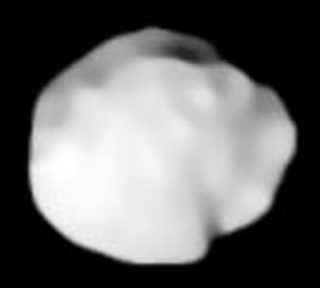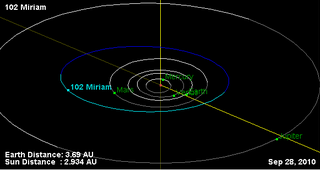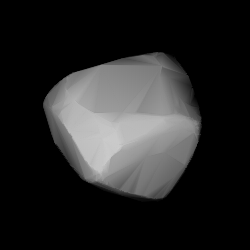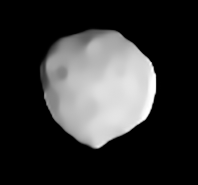
Vesta is one of the largest objects in the asteroid belt, with a mean diameter of 525 kilometres (326 mi). It was discovered by the German astronomer Heinrich Wilhelm Matthias Olbers on 29 March 1807 and is named after Vesta, the virgin goddess of home and hearth from Roman mythology.

Pallas is the third-largest asteroid in the Solar System by volume and mass. It is the second asteroid to have been discovered, after Ceres, and is a likely remnant protoplanet. Like Ceres, it is believed to have a mineral composition similar to carbonaceous chondrite meteorites, though significantly less hydrated than Ceres. It is 79% the mass of Vesta and 22% the mass of Ceres, constituting an estimated 7% of the mass of the asteroid belt. Its estimated volume is equivalent to a sphere 507 to 515 kilometers in diameter, 90–95% the volume of Vesta.

Juno is a large asteroid in the asteroid belt. Juno was the third asteroid discovered, in 1804, by German astronomer Karl Harding. It is one of the twenty largest asteroids and one of the two largest stony (S-type) asteroids, along with 15 Eunomia. It is estimated to contain 1% of the total mass of the asteroid belt.

Astraea is an asteroid in the asteroid belt. This object is orbiting the Sun at a distance of 385 million kilometres (2.5735 AU) with a period of 4.13 yr and an orbital eccentricity of 0.19. The orbital plane is inclined at an angle of 5.37° to the plane of the ecliptic. It is spinning with a period of 16.8 h. The surface of Astraea is highly reflective and its composition is probably a mixture of nickel–iron with silicates of magnesium and iron. It is an S-type asteroid in the Tholen classification system.

Miriam is a moderately large, very dark main belt asteroid. It was discovered by C. H. F. Peters on August 22, 1868, from the Litchfield Observatory.

Antigone is a large main-belt asteroid. Radar observations indicate that it is composed of almost pure nickel-iron. It and other similar asteroids probably originate from the core of a shattered Vesta-like planetesimal which had a differentiated interior. It was discovered by German-American astronomer C. H. F. Peters on February 5, 1873, and named after Antigone, the Theban princess in Greek mythology.

333 Badenia is a large background asteroid, approximately 72 kilometers in diameter, located the outer region of the asteroid belt. It was discovered on 22 August 1892, by astronomer Max Wolf at the Heidelberg-Königstuhl State Observatory in southwest Germany. The carbonaceous C-type asteroid has a rotation period of 9.9 hours. It was named after the historical Grand Duchy of Baden that existed until 1918, and where the discovering observatory is located. Badenia was the first asteroid to receive a provisional designation.
460 Scania is a background asteroid and a slow rotator from the central regions of the asteroid belt. It was discovered by German astronomer Max Wolf at the Heidelberg-Königstuhl State Observatory on 22 October 1900. The uncommon K-type asteroid has an exceptionally long rotation period of 164.1 hours and measures approximately 21 kilometers in diameter. It was named after the Swedish region of Scania, where a meeting was held by the Astronomische Gesellschaft in 1904.
619 Triberga is a main belt asteroid discovered on 22 October 1906 by August Kopff at Heidelberg-Königstuhl State Observatory. Since it has an orbit that repeats itself almost exactly every four years with respect to the position of the Sun and Earth, it has been suggested as a way to calculate the mass of the Moon. Triberga was named for the German town of Triberg.
716 Berkeley is a background asteroid from the central regions of the asteroid belt. It was discovered by Austrian astronomer Johann Palisa at the Vienna Observatory on 30 July 1911. The stony S-type asteroid has a rotation period of 15.6 hours and measures approximately 21 kilometers in diameter. It was named after the city of Berkeley, California, where the discoverer's colleague Armin Otto Leuschner (1868–1953) was the director of the local observatory.
751 Faïna is a very large background asteroid from the central regions of the asteroid belt, approximately 110 kilometers in diameter. It was discovered on 28 April 1913, by Russian astronomer Grigory Neujmin at the Simeiz Observatory on the Crimean peninsula. The elongated C-type asteroid (Ch) has a rotation period of 23.7 hours. It was named after Faina Mikhajlovna Neujmina, colleague and first wife of the discoverer.
760 Massinga is a large background asteroid from the outer regions of the asteroid belt, approximately 70 kilometers in diameter. It was discovered by German astronomer Franz Kaiser at the Heidelberg Observatory on 28 August 1913. The stony S-type asteroid has a rotation period of 10.7 hours and is somewhat elongated in shape. It was named in memory of Adam Massinger (1888–1914), a German astronomer at Heidelberg who was killed in World War I.
779 Nina is a large background asteroid, approximately 80 kilometers in diameter, located in the central region of the asteroid belt. It was discovered on 25 January 1914, by Russian astronomer Grigory Neujmin(1886-1946) at the Simeiz Observatory on the Crimean peninsula. The metallic X-type asteroid with an intermediate albedo has a rotation period of 11.2 hours. It was named after the discoverer's sister, Nina Neujmina (Tsentilovich) (1889–1971).
786 Bredichina is a carbonaceous and very large background asteroid, approximately 104 kilometers in diameter, located in the outer region of the asteroid belt. It was discovered by German astronomer Franz Kaiser at the Heidelberg-Königstuhl State Observatory on 20 April 1914. The elongated C-type asteroid has a longer than average rotation period of 29.4 hours. It was named after Russian astronomer Fyodor Bredikhin (1831–1904).
794 Irenaea is a dark background asteroid from the outer regions of the asteroid belt. It was discovered on 27 August 1914, by Austrian astronomer Johann Palisa at the Vienna Observatory. The presumed C-type asteroid has a rotation period of 9.1 hours and measures approximately 36 kilometers in diameter. It was likely named after Irene Hillebrand, daughter of Austrian astronomer Edmund Weiss (1837–1917).

803 Picka is a large and dark background asteroid from the outer regions of the asteroid belt. It was discovered on 21 March 1915, by Austrian astronomer Johann Palisa at the Vienna Observatory. The carbonaceous D-type asteroid has a rotation period of 5.1 hours and measures approximately 57 kilometers in diameter. It was named after Czech physician Friedrich Pick (1867–1921).
813 Baumeia is a stony background asteroid from the inner regions of the asteroid belt. It was discovered on 28 November 1915, by German astronomer Max Wolf at the Heidelberg Observatory in southwest Germany. The common S-type asteroid has a rotation period of 10.5 hours and measures approximately 12 kilometers in diameter. It was named for H. Baum, a German student of astronomy at Heidelberg who was killed in World War I.
9344 Klopstock, provisional designation 1991 RB4, is a background asteroid from the inner regions of the asteroid belt. It was discovered on 12 September 1991, by German astronomers Freimut Börngen and Lutz Schmadel at the Karl Schwarzschild Observatory in Tautenburg, Germany. Poor observational data suggests that the asteroid is one of the darkest known objects with a diameter of approximately 17 kilometers (11 miles), while it is also an assumed stony asteroid with a much smaller diameter. It has a rotation period of 5.84 hours and was named after German poet Friedrich Gottlieb Klopstock.
5641 McCleese, provisional designation 1990 DJ, is a rare-type Hungaria asteroid and slow rotator, classified as Mars-crosser from the innermost regions of the asteroid belt, approximately 4 kilometers in diameter.
6189 Völk (prov. designation:1989 EY2) is a stony Vesta asteroid, approximately 4 kilometers (2.5 miles) in diameter, located in the inner regions of the asteroid belt. It was discovered on 2 March 1989, by Belgian astronomer Eric Elst at the La Silla Observatory in northern Chile. The S-type asteroid has a short rotation period of 2.9 hours. It was named for Elisabeth Völk, a staff member at ESO headquarters in Germany.









